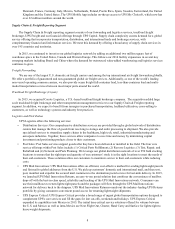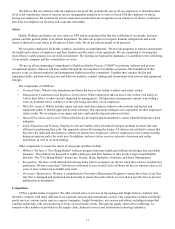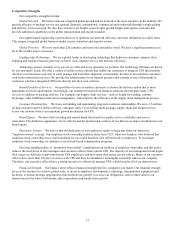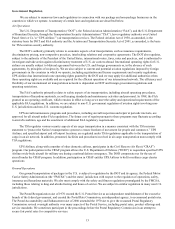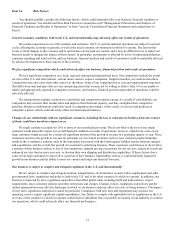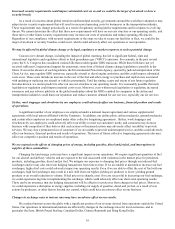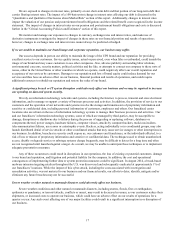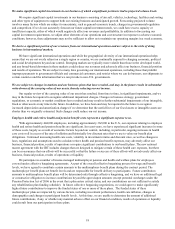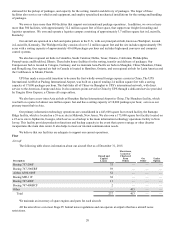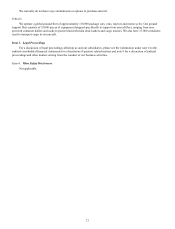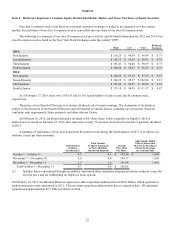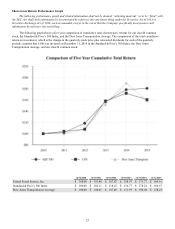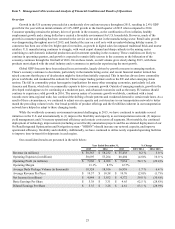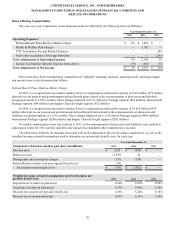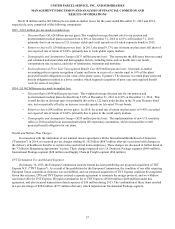UPS 2015 Annual Report Download - page 29
Download and view the complete annual report
Please find page 29 of the 2015 UPS annual report below. You can navigate through the pages in the report by either clicking on the pages listed below, or by using the keyword search tool below to find specific information within the annual report.17
We are exposed to changes in interest rates, primarily on our short-term debt and that portion of our long-term debt that
carries floating interest rates. The impact of a 100-basis-point change in interest rates affecting our debt is discussed in the
“Quantitative and Qualitative Disclosures about Market Risk” section of this report. Additionally, changes in interest rates
impact the valuation of our pension and postretirement benefit obligations and the related benefit cost recognized in the income
statement. The impact of changes in interest rates on our pension and postretirement benefit obligations and costs is discussed
further in the "Critical Accounting Policies and Estimates" section of this report.
We monitor and manage our exposures to changes in currency exchange rates and interest rates, and make use of
derivative instruments to mitigate the impact of changes in these rates on our financial position and results of operations;
however, changes in exchange rates and interest rates cannot always be predicted or hedged.
If we are unable to maintain our brand image and corporate reputation, our business may suffer.
Our success depends in part on our ability to maintain the image of the UPS brand and our reputation for providing
excellent service to our customers. Service quality issues, actual or perceived, even when false or unfounded, could tarnish the
image of our brand and may cause customers to use other companies. Also, adverse publicity surrounding labor relations,
environmental concerns, security matters, political activities and the like, or attempts to connect our company to these sorts of
issues, either in the United States or other countries in which we operate, could negatively affect our overall reputation and
acceptance of our services by customers. Damage to our reputation and loss of brand equity could reduce demand for our
services and thus have an adverse effect on our business, financial position and results of operations, and could require
additional resources to rebuild our reputation and restore the value of our brand.
A significant privacy breach or IT system disruption could adversely affect our business and we may be required to increase
our spending on data and system security.
We rely on information technology networks and systems, including the Internet, to process, transmit and store electronic
information, and to manage or support a variety of business processes and activities. In addition, the provision of service to our
customers and the operation of our networks and systems involve the storage and transmission of proprietary information and
sensitive or confidential data, including personal information of customers, employees and others. Our franchised center
locations also are reliant on the use of information technology systems to manage their business processes and activities. Our
and our franchisees’ information technology systems, some of which are managed by third-parties, may be susceptible to
damage, disruptions or shutdowns due to failures during the process of upgrading or replacing software, databases or
components thereof, power outages, hardware failures, computer viruses, attacks by computer hackers, malicious insiders,
telecommunication failures, user errors or catastrophic events. Hackers, acting individually or in coordinated groups, may also
launch distributed denial of service attacks or other coordinated attacks that may cause service outages or other interruptions in
our business. In addition, breaches in security could expose us, our customers and franchisees, or the individuals affected, to a
risk of loss or misuse of proprietary information and sensitive or confidential data. The techniques used to obtain unauthorized
access, disable or degrade service or sabotage systems change frequently, may be difficult to detect for a long time and often
are not recognized until launched against a target. As a result, we may be unable to anticipate these techniques or to implement
adequate preventative measures.
Any of these occurrences could result in disruptions in our operations, the loss of existing or potential customers, damage
to our brand and reputation, and litigation and potential liability for the company. In addition, the cost and operational
consequences of implementing further data or system protection measures could be significant. In August 2014, a broad-based
malware intrusion targeting retailers throughout the U.S. was discovered and subsequently eradicated at approximately 1% of
our franchisees’ locations. While the impact of this cyber-attack, including the costs associated with investigation and
remediation activities, was not material to our business and our financial results, our efforts to deter, identify, mitigate and/or
eliminate any future breaches may not be successful.
Severe weather or other natural or manmade disasters could adversely affect our business.
Severe weather conditions and other natural or manmade disasters, including storms, floods, fires or earthquakes,
epidemics or pandemics, or terrorist attacks, conflicts or unrest, may result in decreased revenues, as our customers reduce their
shipments, or increased costs to operate our business, which could have an adverse effect on our results of operations for a
quarter or year. Any such event affecting one of our major facilities could result in a significant interruption in or disruption of
our business.



